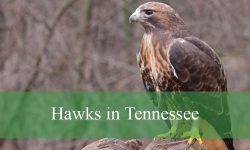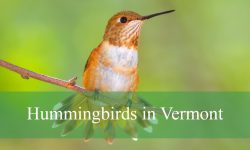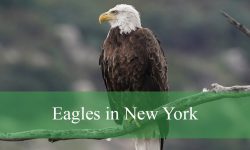Florida is home to a surprising variety of doves and pigeons, from tiny ground-foragers to tropical forest dwellers. These birds can be seen in cities, beaches, farmlands, and forests, offering birdwatchers both familiar sights and rare surprises. Learning to identify them by their markings, calls, and behaviors can make every nature walk more rewarding.
In this guide, we’ll explore 11 fascinating dove species found in Florida, complete with detailed descriptions, behaviors, habitat preferences, and fun facts.
Common Doves Found in Florida
Mourning Dove (Zenaida macroura)
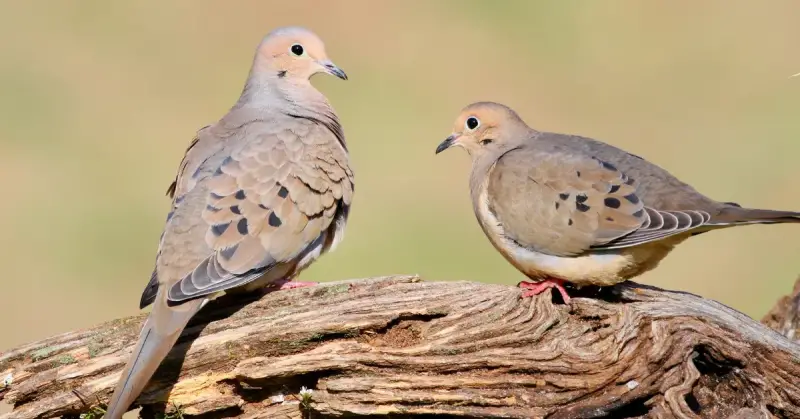
The Mourning Dove is one of the most familiar and widespread dove species in North America, and Florida is no exception. This medium-sized bird has a slender body, long pointed tail with white edges, and soft, grayish-brown plumage. Its small head and black eye, set against a subtle blue eye ring, give it a gentle expression. The wing feathers are marked with black spots, and males are slightly more colorful with a light pink hue on the chest.
Its cooing call is soft and haunting—”coo-OO-oo, oo, oo”—which is where the species gets its name. This sad-sounding call can be heard throughout the year in Florida, especially in the early mornings and late afternoons. In flight, Mourning Doves produce a sharp whistling sound with their wings that helps startle predators and warn others. They are strong fliers and can reach speeds up to 55 mph.
Mourning Doves are ground foragers, feeding primarily on seeds from grasses, weeds, and grains. They are often seen feeding in pairs or small groups in open habitats like farmland, roadsides, grasslands, and suburban lawns. In Florida, they are abundant year-round and are common visitors to backyard feeders that offer millet, cracked corn, and sunflower seeds.
A fun fact: Mourning Doves can drink water without tilting their heads back—unlike most birds. This makes them especially well-adapted to dry or open habitats. Their peaceful nature and soft coloration also make them symbolic in various cultures as messengers of peace and love.
Common Ground-Dove (Columbina passerina)
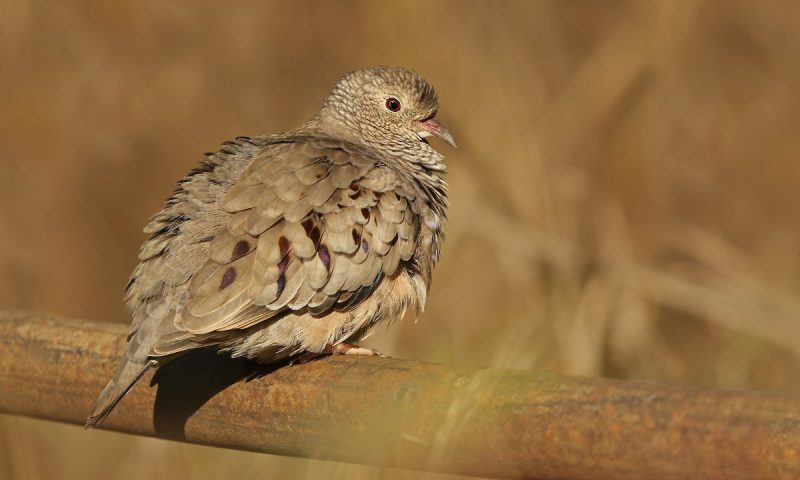
The Common Ground-Dove is the smallest dove species found in Florida, measuring only about 6 inches in length. It has a compact, chunky body with a short tail and a scaled appearance on the breast and head. The plumage is generally light brown or grayish with subtle pink tones, and it shows rust-colored wings during flight, which are a key identification mark.
Its vocalization is a soft, repetitive “wut-wut-wut” or “whoop-whoop,” sounding more like a toy whistle than a typical dove coo. Unlike more vocal species, it tends to call sporadically and quietly from low perches or while hidden among vegetation. This species is shy and more often heard before seen, especially in the early morning.
Common Ground-Doves prefer dry, open habitats like pine flatwoods, sandy scrublands, agricultural fields, and roadside edges. They forage almost exclusively on the ground, feeding on small seeds, grains, and the occasional insect. In Florida, they are permanent residents throughout the peninsula and are particularly common in central and southern regions.
A fascinating fact: These doves often take dust baths to maintain their plumage. They will settle in soft dirt or sand and use their wings to toss the soil onto themselves. This behavior helps remove parasites and keeps their feathers in top condition.
Eurasian Collared-Dove (Streptopelia decaocto)
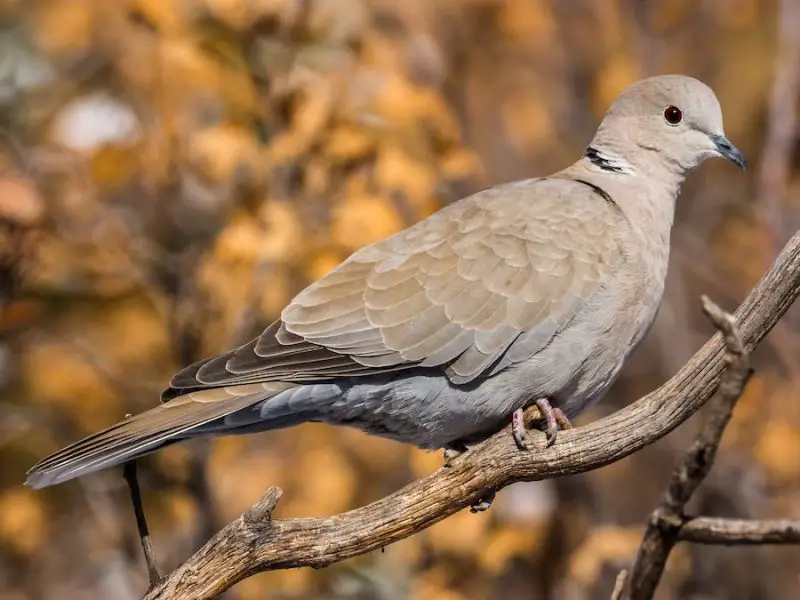
The Eurasian Collared-Dove is a non-native species that was first recorded in Florida in the 1980s and has since expanded rapidly across the state. It is larger than the Mourning Dove and has pale, buff-gray plumage, a squared tail, and a distinctive black crescent or “collar” on the back of the neck. The eye is red with a thin white ring, giving it a striking facial appearance.
Its song is a rhythmic, three-part coo: “coo-COO-coo,” which is deeper and more deliberate than the Mourning Dove’s call. These doves are also known to produce a harsh “haaah” call when startled. Their presence is often betrayed by this sound, especially in neighborhoods where they perch on rooftops, wires, or palm trees.
Eurasian Collared-Doves thrive in urban and suburban environments, often gathering near grain silos, bird feeders, and farms. In Florida, they are common year-round throughout the entire state. They feed mainly on seeds, grains, and occasionally berries, foraging on the ground or visiting platform feeders.
An interesting fact about this species: Despite being introduced relatively recently, the Eurasian Collared-Dove is now one of the most common doves in Florida. It spread across the United States in just a few decades, showcasing one of the most successful avian range expansions in North America.
White-winged Dove (Zenaida asiatica)

The White-winged Dove is a robust, medium-sized dove that has become increasingly common in Florida, especially in the southern and central parts of the state. It is easily recognized by the bold white stripe along its wings, visible both at rest and in flight. The bird has a light brown to grayish body, bright orange eyes surrounded by a blue eye ring, and a short, square-tipped tail.
Its call is a loud, hooting “who-cooks-for-you” that can carry quite far, often heard at dawn or dusk. During the breeding season, males give a slow series of rhythmic coos, sometimes accompanied by wing-flapping displays. They are also known for the audible wing claps during takeoff.
White-winged Doves prefer desert-like or semi-arid environments but have adapted well to Florida’s urban settings, citrus groves, and palm-rich neighborhoods. They are year-round residents in the southern half of the state and expand northward during summer months. Their diet includes grains, seeds, and fruits, especially from palm trees, cacti, and ornamental shrubs.
Fun fact: White-winged Doves have a unique ecological relationship with saguaro cacti in the Southwest, where they pollinate flowers and feed on the fruits. In Florida, while saguaros are absent, they’ve adapted to local fruiting trees just as successfully.
Rock Pigeon (Columba livia)
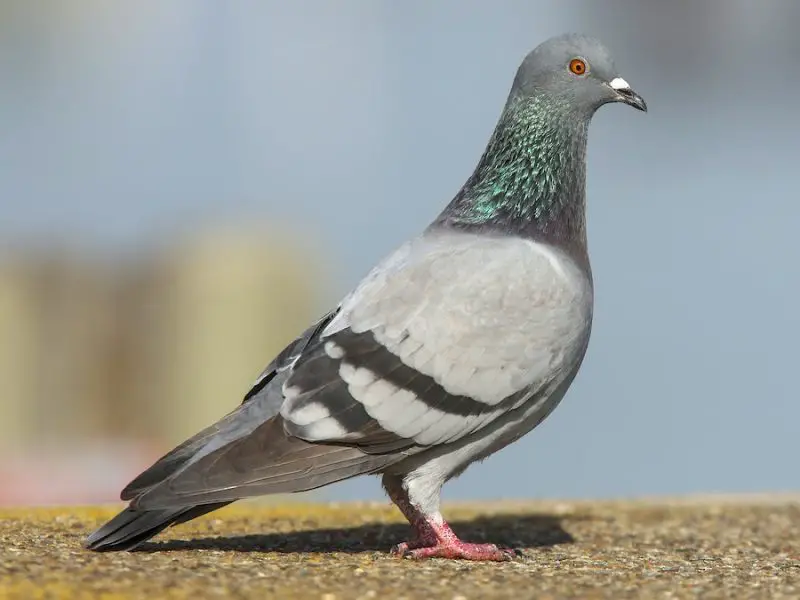
The Rock Pigeon, commonly known as the “city pigeon,” is one of the most ubiquitous birds in urban Florida. Native to Europe, Asia, and North Africa, this species was introduced centuries ago and is now naturalized worldwide. It has a stout body, short neck, and a wide range of color morphs, though the typical form is gray with iridescent green and purple feathers on the neck and two dark wing bars.
Its vocalizations consist of a soft, rolling “coo-roo-coo” and various low-pitched grunts. These sounds are commonly heard around parks, underpasses, or city plazas where pigeons gather in large numbers. Their coos often accompany courtship behavior, such as bowing and puffing up the chest.
Rock Pigeons thrive in human-altered landscapes, nesting on buildings, bridges, and other structures that mimic the cliffs and ledges they historically used. In Florida, they are permanent residents in every city and town, where they forage on discarded food, grains, and seeds. Though not usually attracted to feeders, they readily consume spilled seed.
Fun fact: Rock Pigeons were the first birds domesticated by humans over 5,000 years ago. They have served as messengers, racing birds, and even war-time couriers, thanks to their incredible homing ability.
White-crowned Pigeon (Patagioenas leucocephala)
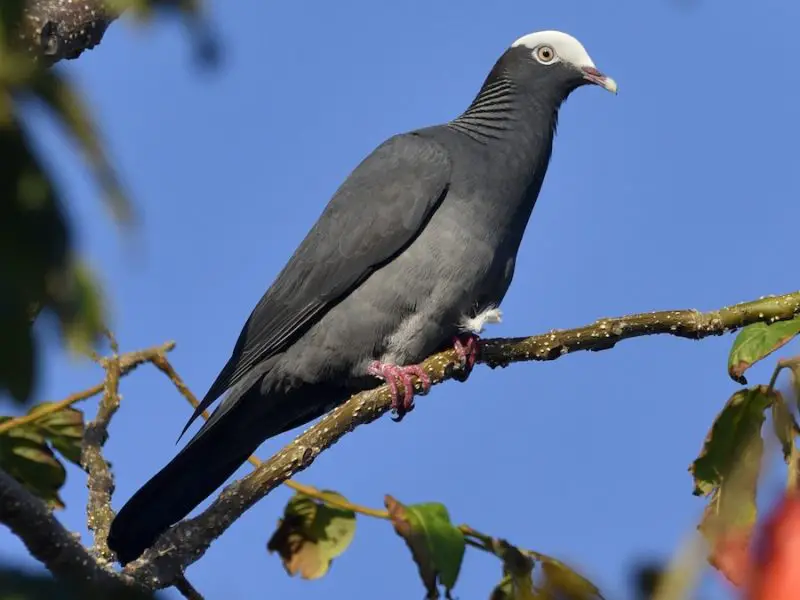
The White-crowned Pigeon is a large, dark-colored pigeon native to the Caribbean and the southernmost regions of Florida. It is best identified by its slate-gray body, white crown on the head, and pale yellow eyes. The wings and tail appear slightly darker, and the overall appearance is sleek and elegant. Males and females look similar, although juveniles may lack the bright white cap.
Its call is a low, repetitive “coo-coo-coo,” often given in bursts and heard more frequently during the breeding season. These pigeons are usually shy and hard to approach, often remaining high in the forest canopy or flying swiftly over mangroves. Their flight is strong and direct, often covering large distances between roosting and feeding sites.
White-crowned Pigeons are found primarily in the Florida Keys and southern tip of the peninsula. They nest in coastal mangroves and forage in tropical hardwood hammocks, where they feed on the fruit of native trees like poisonwood, blolly, and pigeon plum. Their survival is tightly linked to undisturbed island habitats, making them vulnerable to habitat loss.
Fun fact: This species is considered a conservation concern in Florida, in part because it relies heavily on the fruit of poisonwood trees, which are often removed by humans due to their toxic effects on skin. Protecting these trees is essential to the White-crowned Pigeon’s survival in the state.
Zenaida Dove (Zenaida aurita)

The Zenaida Dove is a close relative of the Mourning Dove but more compact and richly colored. It has a warm brown body, bold white wing bars visible in flight, and a shorter, more rounded tail. A distinguishing feature is the bluish skin around the eyes and a subtle pink blush on the chest. It is rare in Florida but has been recorded in the Keys and southern coastal areas.
The bird’s song is a deep, rolling coo similar to the Mourning Dove’s but slightly slower and more emphatic. Males sing from low branches or rocks, often with a bowing motion. It’s a quiet species overall, and its calls are often missed unless you’re specifically listening in the right habitat.
Zenaida Doves are typically found on Caribbean islands but occasionally stray into southern Florida, especially the Keys. When present, they favor dry forests, coastal thickets, and scrubby areas. Their diet includes seeds, small fruits, and invertebrates, foraged mainly from the ground.
A fun fact: In the Bahamas and other parts of the Caribbean, the Zenaida Dove is a culturally significant game bird and has even been featured on currency and postage stamps. Florida is at the northern edge of its potential range, so sightings are always notable for birders.
Key West Quail-Dove (Geotrygon chrysia)

The Key West Quail-Dove is a secretive and stunning ground-dwelling dove rarely seen in Florida, though it historically bred in the Keys. It has a rich reddish-brown plumage with iridescent green on the wings, a bold white stripe under the eye, and a rounded tail. Its body shape is more like a quail, with strong legs adapted for walking through dense understory.
Its call is a soft, mournful “coo” often given from the ground or low perches, and it’s seldom heard unless the area is very quiet. Unlike other doves, the Key West Quail-Dove avoids open areas and rarely takes flight unless disturbed, preferring to walk or run through thick vegetation.
In Florida, it is considered a vagrant or possibly extirpated breeder. It inhabits shady forests and hardwood hammocks, especially in the lower Keys. The species forages on the forest floor for seeds, berries, and small invertebrates. Its preferred environment is rapidly disappearing, contributing to its rarity.
Fun fact: The Key West Quail-Dove was once more common in Florida, but habitat loss and predation by invasive species such as feral cats have drastically reduced its presence. Today, sightings are exciting and extremely rare events for birdwatchers.
Ruddy Quail-Dove (Geotrygon montana)

The Ruddy Quail-Dove is another ground-dwelling dove, even rarer than the Key West Quail-Dove in Florida. It is richly colored with a reddish-brown or chestnut body, a pale face, and bold white markings on the head. Males are brighter than females and have a beautiful iridescence that shines in dappled forest light.
Its vocalizations are deep, owl-like “whoo-oo” calls, given infrequently and usually during the breeding season. This dove is shy and solitary, staying low to the ground and moving slowly and deliberately through dense cover. If disturbed, it flushes suddenly with whirring wings and quickly vanishes into the shadows.
While common in the Caribbean and Central America, Ruddy Quail-Doves are extremely rare in Florida. Most records are from southern counties and the Keys, usually after storms or in preserved forest tracts. They feed on fallen seeds, fruit, and small insects on the forest floor.
A fascinating fact: The Ruddy Quail-Dove’s cryptic behavior and plumage make it one of the most challenging doves to observe in Florida. Some sightings have occurred after hurricanes, which can blow individuals far from their typical range.
Inca Dove (Columbina inca)
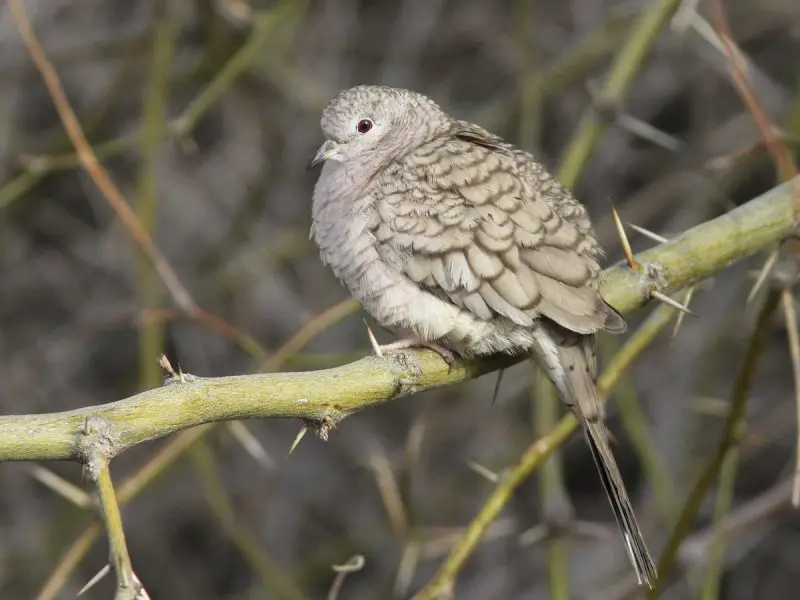
The Inca Dove is a small, slender dove with tan or gray-brown plumage and a scaly pattern that gives it a unique appearance. Its long, squared tail has white edges and is often spread like a fan during flight or displays. Though more common in the southwestern U.S., it has been recorded sporadically in Florida, especially in the panhandle and southern regions.
Its call is a soft “coo-coo-coo” that rises in pitch, often sounding like the notes of a wind-up toy. They also make a rattling sound when they take off, produced by their wings. These doves are social and often seen in small groups near feeders, rooftops, or open yards.
Inca Doves prefer dry, open habitats with scattered trees and shrubs. In Florida, they are considered rare visitors but have shown up in suburban gardens, parks, and disturbed areas with plenty of seed-bearing plants. They feed primarily on seeds and occasionally take small insects.
Fun fact: When it’s cold, Inca Doves engage in a behavior called “pyramid roosting,” where multiple individuals pile on top of each other in layers to stay warm—a remarkable example of social cooperation among birds.
African Collared-Dove (Streptopelia roseogrisea/domestica hybrid)
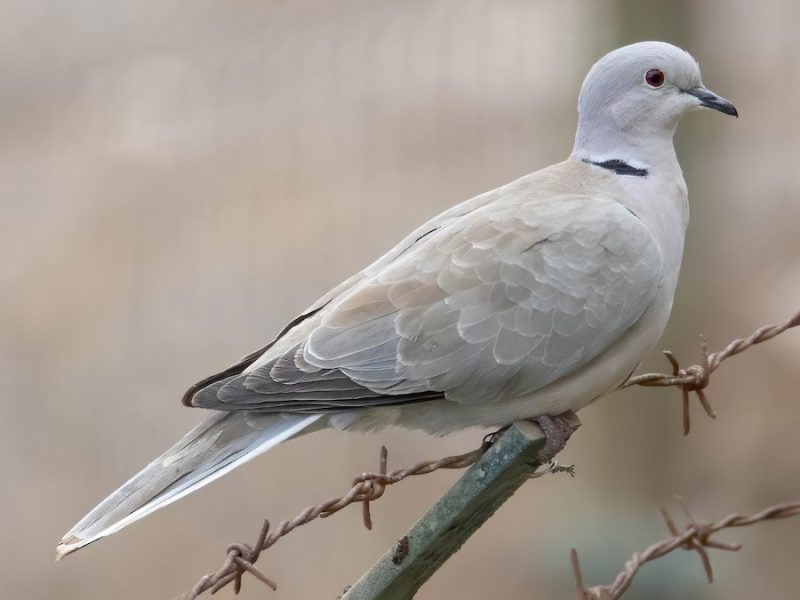
The African Collared-Dove is a domestic species that resembles the Eurasian Collared-Dove but is slightly paler, with a more uniform color and less iridescence. It is believed that many sightings in Florida are of hybrids or domestic escapees from the pet trade. It has a small black collar on the back of the neck and red eyes.
Its call is similar to that of the Eurasian Collared-Dove but may be softer or more variable depending on the individual. These birds can be quiet and inconspicuous, often mixing with other dove flocks in suburban areas or aviaries.
In Florida, African Collared-Doves are not officially countable by birding organizations, as they are considered domestic or non-established. However, sightings do occur, especially in southern cities and near aviaries or exotic bird enclosures. Their behavior is similar to other doves—ground foraging, perching on wires, and feeding on seeds and grains.
A curious fact: Because they are closely related to Eurasian Collared-Doves and capable of interbreeding, some African Collared-Dove individuals in Florida may actually be hybrids, blurring the lines between wild and domestic bird populations.
FAQs About Doves in Florida
What is the most common dove species in Florida?
The Mourning Dove is the most common dove in Florida. It can be seen year-round across the state in a wide variety of habitats, including backyards, farmlands, grasslands, and parks. Its soft, mournful cooing and long, pointed tail make it easy to identify.
Are Eurasian Collared-Doves native to Florida?
No, Eurasian Collared-Doves are not native to Florida. They were introduced to the state in the 1980s and have since spread rapidly. They are now a familiar sight across urban and suburban areas, especially near bird feeders and rooftops.
Where can I see White-crowned Pigeons in Florida?
White-crowned Pigeons are mostly found in southern Florida and the Florida Keys. They prefer coastal mangrove forests and tropical hardwood hammocks and are most active during the breeding season in spring and summer.
What’s the smallest dove in Florida?
The Common Ground-Dove is the smallest dove species in Florida. It measures only about 6 inches in length and is often seen walking along sandy or grassy areas. Its rust-colored wings in flight and scaly appearance help with identification.
Do any rare or vagrant dove species occur in Florida?
Yes, several rare or vagrant species have been recorded in Florida, including the Key West Quail-Dove, Zenaida Dove, Ruddy Quail-Dove, and Inca Dove. These are not commonly seen but may appear in southern Florida, especially after tropical storms.
What do doves in Florida eat?
Most doves in Florida eat seeds, grains, and fruits, with some species occasionally consuming insects. Ground-foraging behavior is common, and many species will visit bird feeders offering millet, cracked corn, and sunflower seeds.
Are any dove species protected or declining in Florida?
The White-crowned Pigeon is considered a species of conservation concern in Florida due to habitat loss and disturbance. Protecting coastal mangroves and fruiting hardwoods is vital for their continued survival.
Can I attract doves to my backyard in Florida?
Yes, you can attract doves by providing ground-level or platform feeders with seeds like millet and cracked corn. Planting native fruiting trees and shrubs also helps. Be sure to keep cats and predators away, as many doves forage on the ground.
Do doves mate for life?
Many dove species, including Mourning Doves and White-winged Doves, are known to form monogamous pair bonds during the breeding season. Some pairs may even mate for life, sharing incubation duties and raising multiple broods per year.
What time of year are doves most active in Florida?
While most doves are active year-round in Florida, breeding activity increases in spring and summer, especially from March to August. During this time, males sing more frequently, and pairs may nest multiple times throughout the warm months.



